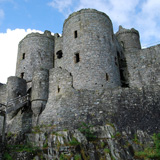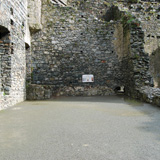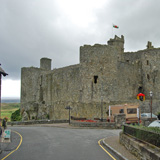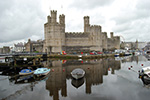History
Harlech Castle is a concentric castle built between 1283 and 1290, taking only seven years to complete. It was constructed by Master James of St George, the chief architect of Edward I's castles in northern Wales, which made up Edward's Ring of Iron or Iron Ring of Castles.
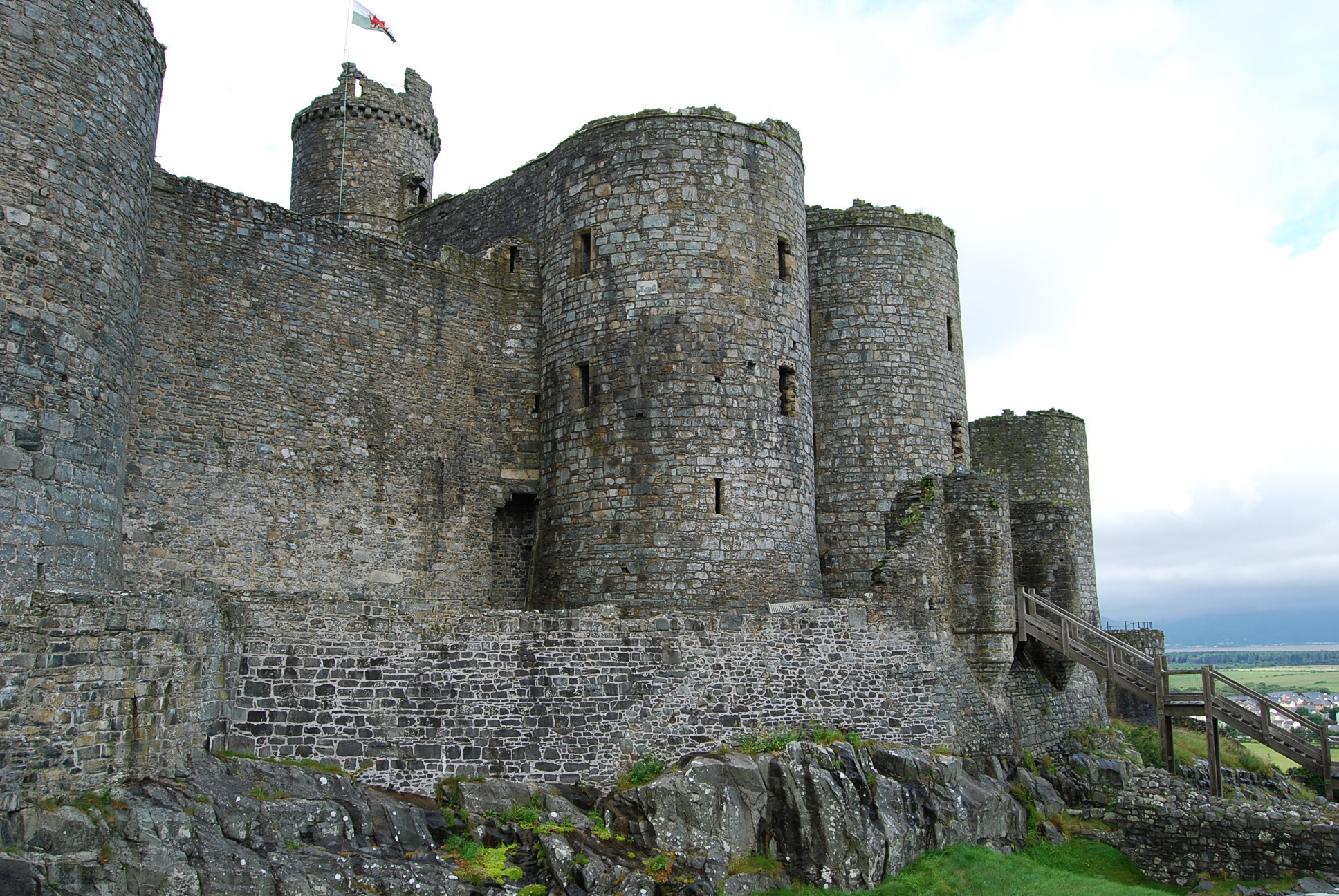
Following a long feud between the Welsh Prince, Llywelyn ap Gruffudd, and King Edward I of England after the Prince refused to pay homage to the King, Llywelyn ap Gruffudd was killed in an ambush by English troops near Builth, Wales, in December of 1282. This led to Edward building a ring of fortifications around northern Wales to subdue the Welsh. Fourteen castles were built, some from scratch by the English and some Welsh castles taken by the English and further fortified; this became known as Edward's Ring of Iron or Iron Ring of Castles. Harlech Castle was one of the most important of these fourteen castles.
By May of 1283, the construction of Harlech Castle was well underway, beginning with the inner curtain walls being raised to a height of about 15 feet, which allowed the castle to be garrisoned and provide protection and accommodation for the builders while they continued to build. Building work in 1284 and 1285 saw the lower section of the gatehouse and outer curtain walls begin to take shape. By the end of 1285, rooms in the gatehouse were being prepared as living quarters for the castle constable, Sir John de Bonvillars. In 1290, Edward I appointed Master James of St George as constable of Harlech Castle, which Master James held for the next three years, living at Harlech Castle while completing the design and construction here as well as other castles of the Iron Ring. The last pieces of Harlech Castle were put into place in 1289, which saw the construction of the two western towers facing the sea and the completion of the gatehouse and eastern towers to their full height.
During the rising of Madog ap Llywelyn between 1294 and 1295, Harlech Castle was put to its first test when it was cut off by land by Welsh forces. But due to the castle's coastal location against the sea, it was resupplied by boat from Ireland and held out, causing the Welsh to give up on the siege. Between 1323 and 1324, Harlech Castle was strengthened even further when the bridge approach to the gatehouse was fortified with two additional towers in front of the gateway.
During the great Welsh uprising led by Owain Glyndŵr between 1400 and 1414, the castles of Aberystwyth, Beaumaris, Caernarfon, and Harlech became isolated outposts of English authority. Records from that time show that Harlech Castle struggled to maintain defensible supplies and had few supplies such as shields, basinets, lances, and dwindling amounts of iron and lead. After a long siege, Harlech Castle finally surrendered to the Welsh in 1404, giving Owain control of central Wales. Harlech Castle became the residence of his court and family along with Machynlleth. And it was probably at Harlech Castle where he was crowned Prince of Wales in the presence of envoys from Scotland, France, and Spain.
In 1409, Harlech Castle was again under siege, this time by an English army trying to oust the Welsh garrison held up in the castle. The English attacked the castle with cannon fire, including from one massive cannon nicknamed "The King's Daughter," which itself burst during the siege. This attack was likely the cause of the destruction of the east and west outer curtain walls. By February 1409, Harlech Castle fell to the English, a combination of a lack of supplies and constant cannon bombardment.
Harlech Castle also played a role during the Wars of the Roses. In 1460, it provided shelter for Queen Margaret of Anjou, the wife of King Henry VI. Between 1461 and 1468, a Welsh constable, Dafydd ab leuan ab Einion, held it for the Lancastrians. In 1468, after holding out against the Yorkists for almost a decade, King Edward IV determined he needed to capture this outpost of resistance. He empowered Lord William Herbert of Raglan to raise a substantial army and retake Harlech Castle. With a force between 7,000 and 10,000 men, the party converged on Harlech Castle. The Lancastrian forces within the castle held out for less than a month, surrendering the castle on August 14, 1468. The vicious attack on the castle and defense of the castle from the episode is chronicled in the well-known song, "Men of Harlech".
In 1539, Crown surveyors declared that Conwy, Caernarfon, and Harlech castles were unfurnished with means of defense and incapable of being defended. Another survey about 15 years later describes the castle as in utter ruin with a roofless hall and chapel. During the reign of Queen Elizabeth I, (1588-1603), Harlech Castle was used to host the Merioneth Assizes, which led to the castle undergoing some repair, making the gatehouse inhabitable. A paper from 1604 states that the castle…
standinge upon the sea side, with havnes of both sides, be maintained and kepte in reparaccion, so that his magestie may easily fortifie the same – as well as keepe the Countrey in awe from anye insurrection, or rebellion, as alsoe to resist and withstand foraine powers.
During the English Civil War between 1642 and 1648, Harlech Castle saw its last involvement in military activity. In 1644, Harlech Castle was defended on behalf of the king by its constable, Colonel William Owen of Brogyntyn. In June of 1646, the castle was under siege by a parliamentarian force. When the garrison of 16 officers and 28 soldiers finally surrendered on March 15, 1647, Harlech Castle was the last royalist castle to be lost and signified the end of the English Civil War. Parlaimentatrion forces then slighted the castle by destroying two gatehouse staircases, but the order to demolish the castle was never carried out.
Harlech Castle was transferred from the Crown to the Office of Works in 1914, responsible for its care, which conducted many repairs, including the restoration of the arches over the entrance passage of the gatehouse, general overhaul of stonework, and the excavation of the main ward. Since 1969, the castle has been maintained on behalf of the National Assembly of Wales by Cadw; Welsh Historic Monuments.
In 1987, Harlech Castle, Beaumaris Castle, Caernarfon Castle, and Conwy Castle were added to the World Heritage List of Historic Sites of outstanding universal value.
Castle Highlights
Harlech Castle is a fine example of an Edwardian concentric castle. It is nestled on a rocky crag between the mountains of Snowdonia and Tremadog Bay on the northwest coast of Wales. Like Beaumaris Castle further north, it has a lower ring wall with towers surrounding higher castle walls. The lower walls are defendable from the high walls. The high walls also had the gatehouse and corner towers close enough together to defend from the other towers.
This style of castle contains no central keep, so the massive gatehouse was the main residential building. There is also the remains of a barbican in front of the gatehouse. The castle now has a modern “floating” footbridge leading from the car park through the barbican, replacing the wooden steps that were there when I last visited in 2007.
Inside the inner ward of the castle, the stone foundations of the Great Hall and kitchens are to the rear of the castle. Along the north wall are the remains of the chapel and bakehouse. Along the south wall was the granary and a second hall.
The towers, gatehouse, and wall walk along the top of the curtain wall battlements are accessible. Just be careful; there are no safety railings along the battlements, and the walls on either side are lower than knee level. Not for the faint-hearted.
From the castle, 108 steps lead down to the bottom of the castle rock to sea level, where the castle could be accessed directly from the sea before it receded over the centuries, leaving the castle isolated on its rocky perch.
Harlech Castle can be thoroughly visited in 2 hours. If you want to explore more castles on the same day, combine a visit to Criccieth Castle, save Caernarfon Castle for the next day, and couple that with a visit to Beaumaris Castle.
